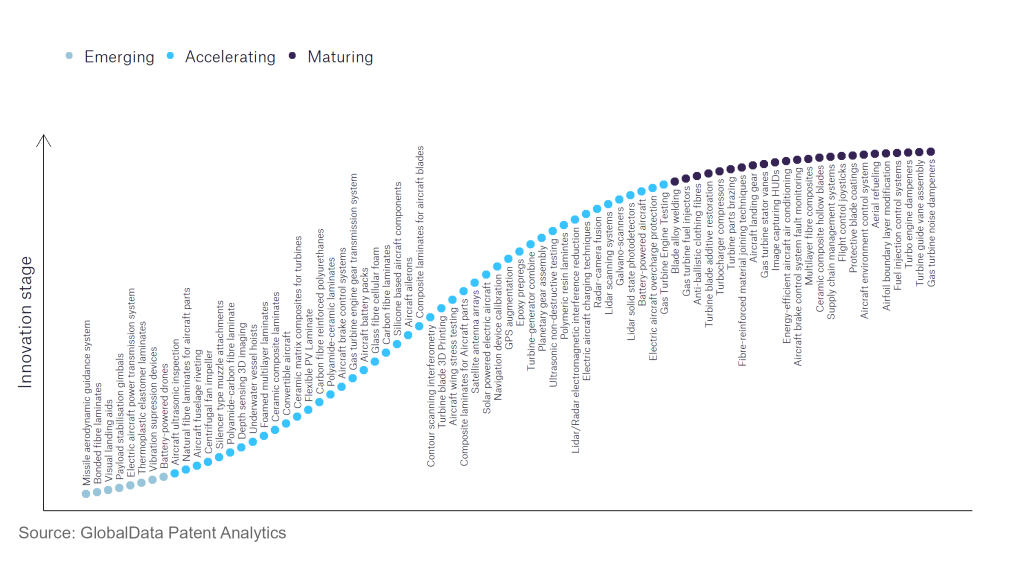The aerospace and defence industry continues to be a hotbed of innovation, with activity driven by the uptake of advanced technology, and growing importance of technologies such as hypersonics and advanced materials. In the last three years alone, there have been over 174,000 patents filed and granted in the aerospace and defence industry, according to GlobalData’s report on Innovation in Aerospace, Defence & Security: Lidar scanning systems. Buy the report here.

Discover B2B Marketing That Performs
Combine business intelligence and editorial excellence to reach engaged professionals across 36 leading media platforms.
However, not all innovations are equal and nor do they follow a constant upward trend. Instead, their evolution takes the form of an S-shaped curve that reflects their typical lifecycle from early emergence to accelerating adoption, before finally stabilising and reaching maturity.
Identifying where a particular innovation is on this journey, especially those that are in the emerging and accelerating stages, is essential for understanding their current level of adoption and the likely future trajectory and impact they will have.
180+ innovations will shape the aerospace and defence industry
According to GlobalData’s Technology Foresights, which plots the S-curve for the aerospace and defence industry using innovation intensity models built on over 262,000 patents, there are 180+ innovation areas that will shape the future of the industry.
Within the emerging innovation stage, bonded fibre laminates, thermoplastic elastomer laminates, and vibration supression devices are disruptive technologies that are in the early stages of application and should be tracked closely. Centrifugal fan impellers, ceramic composite laminates, and gas turbine engine testing are some of the accelerating innovation areas, where adoption has been steadily increasing. Among maturing innovation areas are protective blade coatings and blade alloy welding, which are now well established in the industry
Innovation S-curve for the aerospace and defence industry

LiDAR scanning systems is a key innovation area in aerospace and defence
LiDAR (light detection and ranging) sensors are used to prevent collision of a vehicle with obstacles and other vehicles. This is achieved by the creation of a 3D map of the surrounding environment, through the use of lasers. The resultant images can then be processed and utilised for a range of mission types.
GlobalData’s analysis also uncovers the companies at the forefront of each innovation area and assesses the potential reach and impact of their patenting activity across different applications and geographies. According to GlobalData, there are 30+ companies, spanning technology vendors, established aerospace and defence companies, and up-and-coming start-ups engaged in the development and application of LiDAR scanning systems.
Key players in LiDAR scanning systems – a disruptive innovation in the aerospace and defence industry
‘Application diversity’ measures the number of different applications identified for each relevant patent and broadly splits companies into either ‘niche’ or ‘diversified’ innovators.
‘Geographic reach’ refers to the number of different countries each relevant patent is registered in and reflects the breadth of geographic application intended, ranging from ‘global’ to ‘local’.
Faro Technologies is one of the leading patent filers in LiDAR scanning systems. Some of the LiDAR scanning systems related patents filed by Faro Technologies include developments in cloud-to-cloud comparisons, noise reduction when upscaling images, and the use of LiDAR in augmented and virtual reality settings. Some other key patent filers in the area include Kyocera, Apple, and Innoviz Technologies.
In terms of geographic reach, Kawasaki Heavy Industries leads the pack. Alphabet and Baidu stood in the second and third positions, respectively. By means of application diversity, Sense Photonics held the top position, followed by Stanley Electric, Boeing, Hexagon, and Baidu.
LiDAR scanning systems has a sizeable number of patents filed by companies with a primarily commercial market focus. Defence companies such as Boeing, Raytheon Technologies, and Elbit Systems are also filing patents in this area.
To further understand the key themes and technologies disrupting the aerospace and defence industry, access GlobalData’s latest thematic research report on Defence.
Data Insights
From

The gold standard of business intelligence.
Blending expert knowledge with cutting-edge technology, GlobalData’s unrivalled proprietary data will enable you to decode what’s happening in your market. You can make better informed decisions and gain a future-proof advantage over your competitors.




